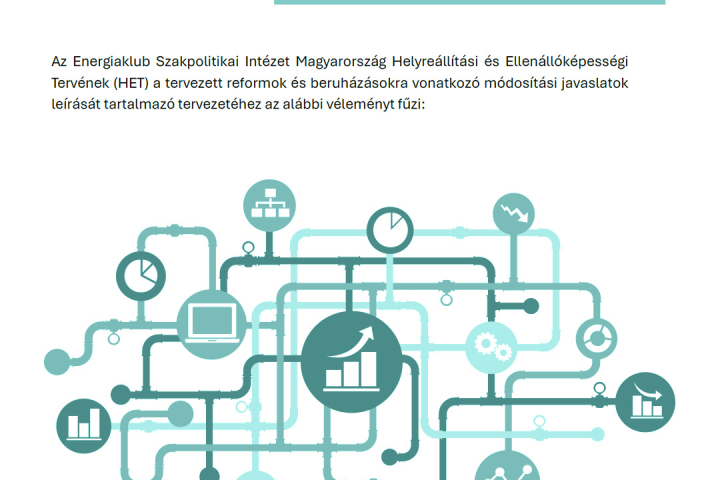Visegrad at a crossroads - JOINT PRESS RELEASE
Renewable associations assessing National Energy Climate Plans before the Energy Council meeting next week.
Visegrad countries are still lacking ambition to bet on renewables, but they are no longer a unified block opposing renewable energy and progressive climate policies. Recently, first new pioneering private initiatives and national policies boosted modest renewables growth in Central Europe. This is the main conclusion of todays presented analysis of National Energy and Climate Plans (NECPs) that were prepared by renewable energy business representatives and experts from Visegrad countries and Austria. NECPs will be discussed next week by energy ministers from EU member states.
Even if Visegrad countries are still lacking ambition to bet on renewables, they are no longer a unified block opposing renewable energy and progressive climate policies. This is one of the main conclusions from renewable energy business representatives from Central Europe made today on their virtual press conference where critical analysis of National Energy and Climate Plans (NECPs) [1] and results of first successful initiatives and policies were presented. According to todays presented findings, there is a partial shift from the main conclusion established by the group a year ago in Prague, when Visegrad+ for Renewable Energy (V+RE) platform had been established. [2] “Fact that this once unity is slowly but clearly falling apart is a very good news for all. From academics and other experts we have learned that Visegrad countries have a great potential for massive renewable energy expansion and now we can see some first signals that these countries want to be part of the European renewable mainstream,” Dirk Hendricks, secretary general, European Renewable Energies Federation (EREF) said.
Energy ministers are meeting by videoconference next Monday 15 June.
Share of renewables in Visegrad countries has been stagnating in recent years (see the chart below), while on average in the EU we could see constant increase of new renewable installations [3]. “My feeling is that while most of Europe understood well that renewables are the future because they help to protect the climate and because they are cheaper and cheaper, leaders in Central Europe presented renewable development more as a homework they got from Brussels. This is slowly changing now,” Ada Amon, senior policy expert in E3G, said.

But recently, many renewable technologies are experiencing a huge interest among companies and households. Successful programs such as Green Savings Programme in Czechia or Green for households in Slovakia would not be a reality without concrete energy and climate policies and also appropriate funding facilitated by these clear goals. The photovoltaics growth to 1.5 GW in the last two years in Poland wouldn’t be possible without favorable regulatory framework. And - last but not least - selling corporate PPAs project started by initiative independent on the Government by Polish Wind Energy Association recently, aims to support additional but gigantic 3.2 gigawatts of wind and photovoltaic capacities by 2030.
“In recent years we can see some successful pioneering initiatives and policies becoming a reality and citizens are eager to engage. But what we essentially lack in all the Visegrad, are the comprehensive and ambitious government policies. Great pioneer instruments that we see in some of the countries are too fragmental to deliver the necessary shift in power sector, unfortunately,” Dirk Hendricks said.
„It is probably too early for such a conclusion, but in Visegrad countries we see some similarities with Austria 15 or 20 years ago, when from their political leaders we used to hear that “there is not wind blowing and the sun is shining little in Austria”. With their wind cooperatives, solar energy exploitation and small scale biomass district heating systems aiming for 100% renewable electricity by 2030, we see Austria among renewable champions”, Ada Amon, senior policy expert in E3G, said.
Do the homework but nothing more
The renewable energy targets set in the NECPs of Visegrad countries are considerably lower than the EU-wide target of 32% renewables share on energy consumption by 2030. Polish NECP indicates
21-23% renewables by 2030, Czechia 22%, Hungary 21% and Slovakia 19.2%. Austria on the other hand seeks 46-50% renewable energy regardless of the sector and 100% of renewable electricity.

Austria
The finalisation and submission of the Austrian NECP was “administered” by the transitional government, and it lacks the necessary ambition to meet the aspired targets regarding the reduction of greenhouse-gas emissions and the development of renewable energy sources. [4]
“We trust that the update of the NECP will follow , the program of the new government, which is even more determined than the NECP. According to that, Austria shall be climate-neutral as of 2040,” Christoph Wagner, president of Austrian Renewable Energy Association EEÖ said.
The Czech Republic's NECP settled on 22% share of renewables on energy consumption in 2030, failing to aim for at least 23% that was recommended by the European Commission's assessment. On the one hand, the plan puts a very large emphasis on solid biomass combustion in district heating despite uncertain supply of sustainable biomass in the next decade due to the bark beetle and drought. On the other hand, the plan is wasting the renewable electricity sector potential, especially wind and photovoltaic. [5] Development of renewables between 2021 and 2030 according to the governmental plan will bring total investments of 12.8 billions EUR as calculated in a recent study by Czech Technical University in Prague [6].
"According to the governmental plan, there will be 600 megawatts of new wind turbines added during the next decade. This is at least three times less than our medium scenario expects. Austria with its similar wind conditions, population density and energy infrastructure is making this every two-three years”, Štěpán Chalupa, Chairman of the Czech Renewable Energy Chamber, said.
The Hungarian NECP’s forecast of 15% increase in primary energy consumption between 2017 and 2030 seems detached from the reality of climate change and declining population. This unlikely assumption of growing primary energy consumption makes it more difficult to achieve a higher ratio of renewable sources. This can explain the unambitious 21% renewable energy target by 2030. The NECP proposes a one-sided expansion of photovoltaics and artificial discouragement of wind energy in spite of its technical potential and competitiveness. [7]
“For real positive changes it would be crucial to involve geographers, natural and social scientists tightly into the energy planning processes. The last decades‘ mere technical approach proved its untenability contributing to the climate disaster and global ecological crisis”, Béla Munkácsy said
Poland can go through energy transition faster and cheaper than stated in the National Energy and Climate Plan. The industry, which is responsible for one third of the country’s annual energy consumption, can be the key decarbonisation driver. Poland’s industry, international and domestic, is growing more and more aware of the advantages the renewable energy brings. Onshore wind is currently the cheapest new energy generation source in Poland and PV costs are also decreasing and becoming more and more attractive. With the yearly electricity consumption of 60 TWh industry in Poland is becoming concerned first with the increasing energy prices posing huge risk to their business competitiveness but also the reputational burden of high carbon footprint of their products. [8]
“Over the years we repeated to ourselves and to the world that we cannot afford to develop renewables. Now we can say, we cannot afford not to invest in RES,” the long-standing PGE Strategic Director Ms. Monika Morawiecka said. PGE Group is the largest energy company in Poland. PGE OE (Renewables) is a member of Polish Wind Energy Association (PWEA).
Slovakia’s ambition to achieve 19.2% of RES in final energy consumption by 2030, as declared in the NECP, is based on flawed assumptions regarding the trajectory of final energy consumption and fails to take into account the technical and economic potential of some renewable technologies. Realistic adjustments of this denominator together with more ambitious yet achievable goals in wind and solar electricity, battery and hydrogen-based electrical mobility (sector of transport) can lead to an overall share of 25.6% renewables by 2030. [9]
“Renewable energy technologies, especially wind and photovoltaics, have already became cost competitive with conventional energy sources. Instead of relying on its high share of nuclear energy Slovakia should perceive this unique opportunity and make real plans to support the development of these climate-positive energy sources coupled with electrical mobility,” stated Ján Karaba, director of SAPI, the leading association of renewable energy in Slovakia.
Sources
[1] Renewables in National Energy and Climate Plans of Visegrad countries. Challenging the low ambition. June 2020
[2] Visegrad+ for Renewable Energy (V+RE), a platform of renewable energy associations from Visegrad Group countries and Austria has been established in Prague in May 2019 to gather representatives of the renewable industries and challenge the low level of ambition in the energy transition in the region. Members of the platform include Czech Renewable Energy Chamber (CZ), Energiaklub (HU), Polish Wind Energy Association (PL), Slovak Association of Photovoltaic and Renewable Energy Industry (SK), Austrian Renewable Energy Association (AT) and E3G.
[3] Eurostat SHARES
[4] Analysis of National Energy and Climate Plan Austria – NECP Evaluation Paper
[5] Česko na cestě k uhlíkové neutralitě
[6] Investment needs for 2030 energy and climate targets in Czechia. January 2020
[8] Analiza „Krajowego planu na rzecz energii i klimatu na lata 2021-2030” z dnia 30 grudnia 2019r.
[9] Slovak analysis will be presented on 24. 6. 2020 during a seminar in Bratislava.







